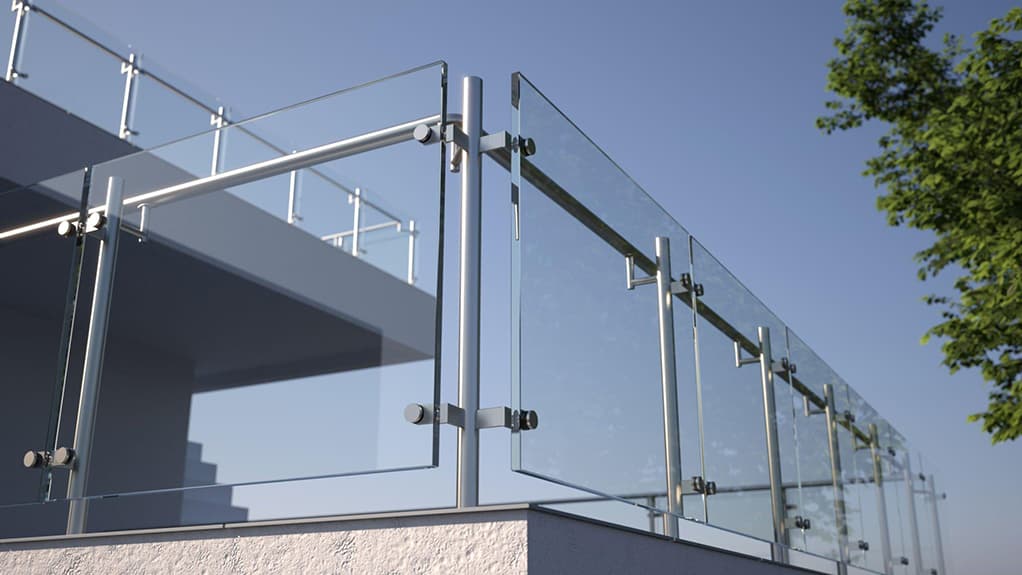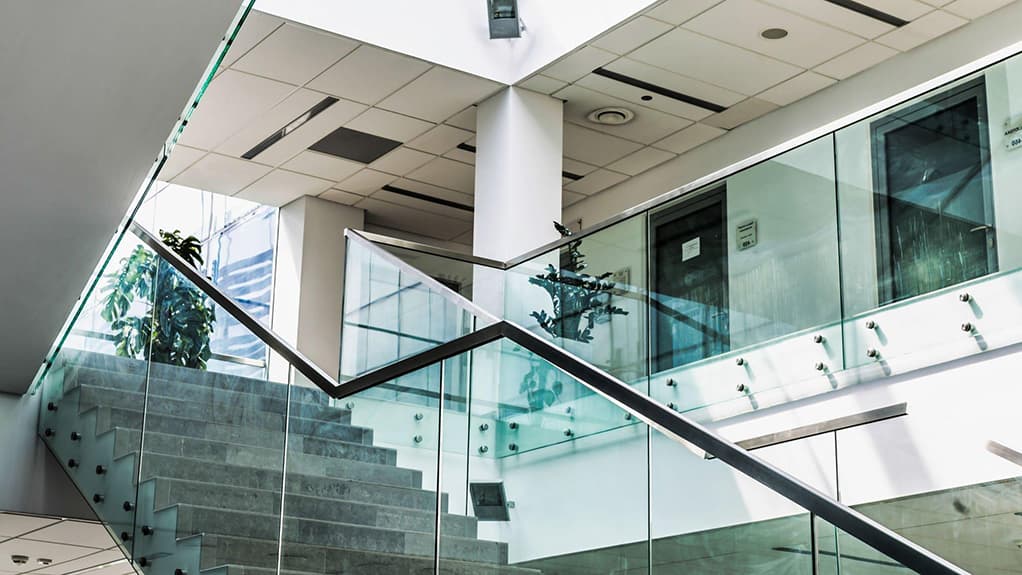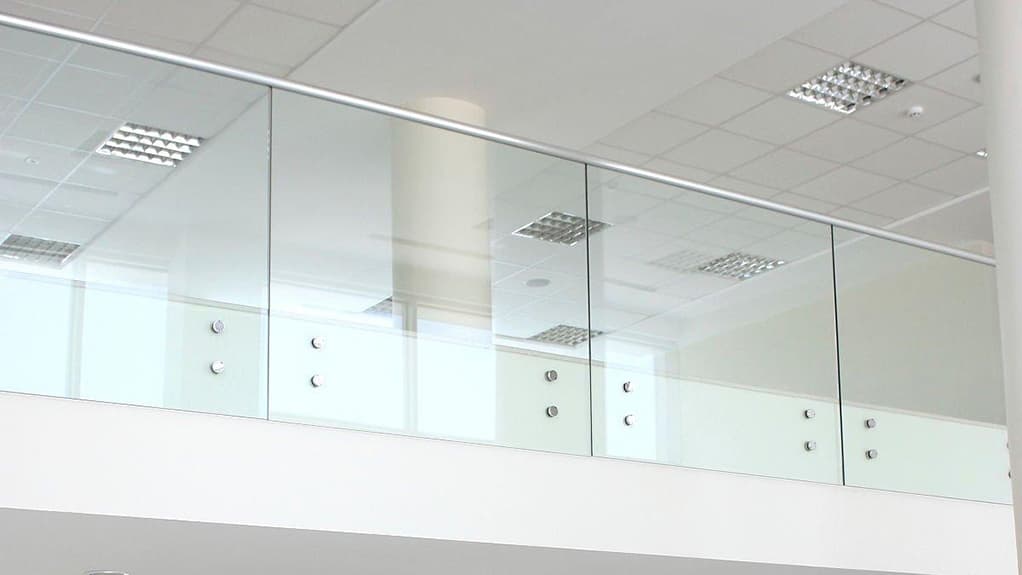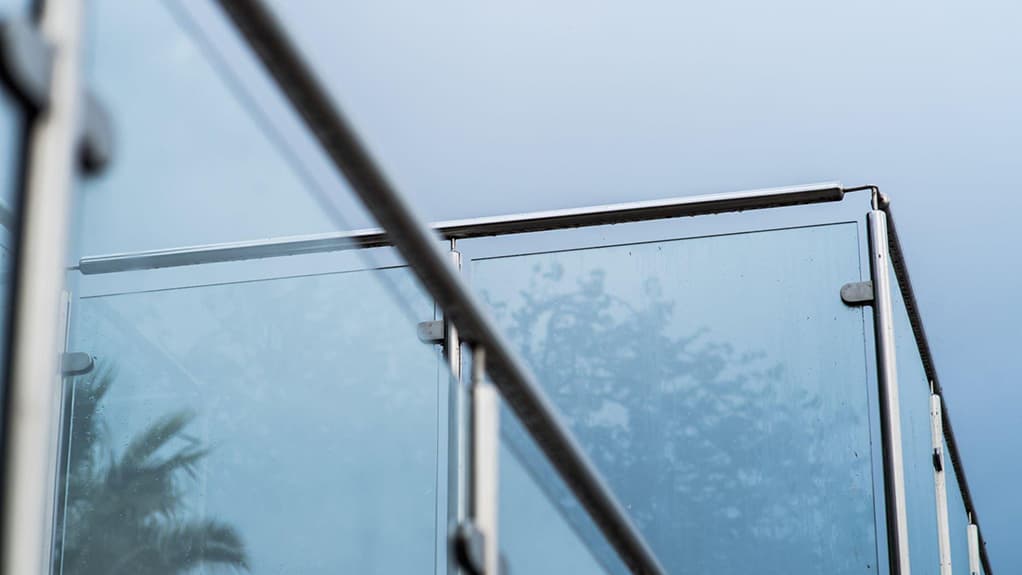Damaged glass railings are a major safety hazard, so making sure they are properly repaired or replaced is an important part of home maintenance. Broken glass railings can be a source of dangerous shards that can cause serious injury. Even if there is no broken glass, weakened or damaged railings may not be able to bear the weight of someone leaning on them. When you consider that railings provide a barrier between your balcony and the ground below, it’s easy to see why it’s important to have sturdy ones in place at all times.
Table of Contents
In addition to being a hazard, damaged glass railings can also create an eyesore. They can detract from the appearance of your home, reducing its curb appeal. You may also be subject to fines or legal action if your damaged glass railings are visible to the public.
Fortunately, repairing or replacing broken or damaged glass railings is a relatively simple process. It involves assessing the damage, removing the old railing, and then either repairing or replacing it with a new one. This guide provides clear instructions on how to safely do this, along with tips for making the process as efficient as possible. It will also look at ways to prevent damage in the future and when is it best to hire a professional for the job.

Overview of Typical Glass Railing Damage and Wear and Tear
Glass railings add a modern look and sleek elegance to any space. They are built to withstand the elements, but it doesn’t mean they don’t suffer the occasional damage or wear and tear over time. Whether you have a modern glass railing system in your home or a vintage wrought iron railing, it pays to be aware of the common types of damage and wear and tear that can occur.
The most common type of damage is breakage. This happens when an object is dropped on the railing or someone leans against it too heavily. Depending on how strong the glass is and how hard it is hit, it can cause either a large crack or shatter completely.
It’s important to note that breakage usually involves some sort of force, whether from an object or from an external force like wind or vibrations. It’s also possible for breakage to occur from within the glass itself if it has weakened over time, typically due to age.
Another type of damage is scratches. These are caused by objects rubbing against the surface of the glass which causes scratches and etchings. While scratches are not as dangerous as breakage, it can still detract from the aesthetics of your railing system.
Finally, weather-related damage is a possibility depending on the type of climate you live in. Sunlight can cause fading which reduces the clarity of the glass, while humidity and temperatures can cause it to warp or distort. In cold weather, the glass may even become more brittle and prone to breakage.
Types of Glass Railing Damage and How to Tell Which One You Have
It is important to be able to identify the type of glass railing damage you are looking at in order to determine the best course of action for repair or replacement. There are several common types of glass railing damage that can occur, and understanding how to tell them apart can help you save time and money.
- Chips – Chips are small indentations in the glass that can be caused by impact with a hard object. These chips range from tiny pinhead-sized holes to larger dents that can be seen with the naked eye. Chips can also be caused by poor installation and improper use.
- Cracks – Small hairline cracks in the glass are usually caused by stress fractures. These cracks tend to start small and then grow as the glass is subjected to more stress. Cracks can also be caused by thermal shock, which happens when the glass heats up suddenly.
- Scratches – Scratches are shallow grooves in the surface of the glass that will be visible if you run your finger over them. Scratches are usually caused by contact with other hard objects and can range from light streaks to deeper gouges.
- Discoloration – This type of glass railing damage is caused by exposure to harmful chemicals and/or ultraviolet (UV) light. The glass can turn yellow, brown or even develop a milky-white haze.
Identifying the type of damage you have can help you decide whether to repair or replace the glass railing. For instance, small chips or scratches can often be repaired with a specialized glass filler and polishing compound, while cracks and discoloration usually require a complete replacement of the glass. It is important to always use glass railing professionals who are experienced in dealing with these types of repairs and replacements.
No matter what type of glass railing damage you have, it is important to address the issue as quickly as possible. Doing so can help you avoid safety hazards and costly repairs down the road.

Assessing the Severity of Damage
Whether you decide to repair or replace glass railings depends on how severe the damage is. Because glass railings are such a prominent feature in any home, it’s important to make sure you properly assess the damage before jumping into any decisions.
To determine how severe the damage is:
- Start by carefully examining the railing for cracks, holes, chips and other signs of damage.
- Check for wear and tear at joints and points of contact.
- Look for water seeping through areas that were once sealed, which can indicate a compromised railing.
- If necessary, use a magnifying glass to inspect the glass more closely.
Once you’ve done your assessment, there are two courses of action you should consider: repairing existing glass railings or replacing them with new ones. If the damage is relatively minor, like a small chip or crack, it can likely be repaired without needing to replace the entire railing.
However, if the damage is extensive and poses a safety risk, replacement may be the best option. In this case, you should hire a professional to help with the process.
Removing, Repairing and Replacing Damaged Glass Railings
If you have noticed damage to your glass railing, it’s essential that you take action to repair or replace the glass railings to keep you and your family safe. It is important to remember that this is a delicate process that needs to be handled with care.
Below is a step-by-step guide to removing, repairing and replacing damaged glass railings:
- Put on safety glasses and gloves, and make sure that the area where you will be working is ventilated.
- Carefully assess the damage to the glass railing. Are any of the posts weakened or damaged? If there are, you may need to replace them, as well as the glass.
- Using a screwdriver, carefully remove any screws holding the glass railing in place.
- Gently lift the glass railing from the posts and set aside. Be careful to avoid putting any strain on the posts.
- Inspect the railing posts for damage. If they are severely damaged or weakened, they should be replaced.* If you are going to repair the glass railing, you will need to obtain a replacement glass panel.* Measure the dimensions of the damaged glass panel and compare it to the measurements of the replacement glass panel.* Carefully slide the replacement glass panel into the railing posts. Make sure that the screws are firmly tightened.* If you are replacing the entire railing, or just the posts, remove the old posts. Use a drill to unscrew the existing posts, then carefully dismantle the railing.
- If you are replacing the posts, take the necessary measurements and purchase the right sized posts.
- Attach the posts to the floor or wall, and make sure they are firmly secured. Insert the new glass panel into the slots on the posts, and secure with screws.
- If the glass has been successfully replaced, check the posts again to make sure they are properly secured.

This guide should give you all the information you need to safely and effectively remove, repair and/or replace damaged glass railings. Be sure to take all of the necessary safety precautions, and don’t attempt any strenuous repairs without professional help.
Replacing glass railings in your home can be a daunting task, but with the right tools and tips, it doesn’t have to be. Taking the time to properly assess the damage and plan ahead will make the repair and replacement process as efficient as possible. Here are some helpful tips that should be considered prior to starting work on your damaged glass railings.
Firstly, be sure to measure the exact size of the railings before you begin. Properly measuring the area where the new or replacement piece is going to be installed will ensure that the repair or replacement goes smoothly and quickly. Make sure to measure the length, width, and thickness, as this will ensure that the exact size piece is purchased or ordered.
Another tip is to always wear safety glasses and gloves when removing and handling glass. This will help to protect your eyes and hands from any potential sharp edges, as well as helping to prevent potential cuts or scrapes.
Finally, be sure to use the correct tools for the job. Using the wrong tools may result in additional damage to the glass railing or the surrounding area. Therefore, it is important to do some research and find the tools that will allow you to complete the repair or replacement with ease and accuracy.
Following these tips will help you make the repair and replacement process as efficient as possible. However, if you find yourself unable to fully assess the damage, it is always best to seek professional help.
Preventing Glass Railing Damage
Glass railings can become damaged due to wear and tear, accidental breakage and other causes. Fortunately, there are some actions you can take to reduce the odds of this happening:
- Avoid placing heavy items on glass railings when possible.
- Do not use abrasive cleaning materials on the railing.
- Regularly inspect the railing for any signs of stress or damage.
- Make sure that the glass railing is installed properly and is reinforced if needed.
- Keep the glass railing away from areas with high foot traffic.
- Make sure that the railing is inspected and maintained on a regular basis.
- If you notice even the smallest of cracks, deal with the issue right away.
Taking good care of your glass railings will ensure that they last for a long time without needing any repairs. In addition, by keeping a watchful eye on the railing, you’ll be able to spot any potential issues before they become serious problems.

When is it Best to Seek Professional Help?
When repairing or replacing glass railings, it can be difficult to know when to call in a professional for help. To ensure your safety as well as getting the best results, there are certain tasks that should only be attempted by an experienced technician. The following signs are a good indication that you should seek professional help:
- The glass railing is attached to a balcony, deck or other outdoor structures
- You have never replaced or repaired a glass railing before
- The damage is extensive and could involve structural risks
- The glass railing has special design elements, such as curved sections
- You lack access to the right tools and materials needed for repairs
In these cases it is always best to bring in an expert who can assess the damage, advise on the best course of action and complete the job safely. A professional technician will also be familiar with all the relevant laws and regulations in the area and will ensure that the finished installation is compliant.
Finally, it is important to remember that a professional technician may also be able to provide additional services, such as anti-corrosion treatments for the metal components of your glass railings, and specialist cleaning solutions for the glass itself.
Glass Railing Safety Guidelines for Household Use
When it comes to glass railing safety, there are certain protocols that must be followed at all times. Whether you’re using the glass railings for a home staircase or a balcony, the following guidelines should be taken into consideration.
Firstly, it’s important to note that glass railings must be cleaned on a regular basis. This helps to prevent the accumulation of dirt, dust, and grime which can have a negative impact on the overall strength and integrity of the glass. Regular cleaning also ensures that the railing is free from any sharp edges that could cause injury.
Secondly, a good quality glass railing installation should be done by a professional. This will ensure that the railing is properly fitted and will be able to withstand the weight of anyone who uses it. An improperly installed railing could result in injuries or even death.
Thirdly, any damage, wear and tear, or corrosion should be reported to a professional immediately. Damaged glass railings can be a safety hazard, as they can easily shatter with enough force. It is advised to have these railings replaced as quickly as possible to prevent any serious mishaps.
Finally, it’s important to install warning signs in areas where the glass railing is in use. This will alert people to any potential dangers before they come too close to the railing.
By following these basic safety guidelines, you can help to ensure that your glass railings are safe to use for many years to come.

Exploring the Different Materials Used for Glass Railing Repair and Replacement
When it comes to repairing or replacing damaged glass railings, there are many different materials available. Here is an overview of the most commonly used material options.
Wood
Wood is one of the most popular materials for glass railing repair and replacement because of its durability and affordability. Wood doesn’t rust and is relatively easy to work with. It’s also lightweight and aesthetically pleasing.
Aluminum
Aluminum is another popular option for glass railing repair and replacement. It’s highly durable, won’t rust, and is lightweight. The downside is that aluminum can be difficult to work with and is more expensive than some other materials.
Stainless Steel
Stainless steel is a very strong material that won’t rust, but it’s also expensive and more difficult to work with. It’s often used in commercial applications, such as office buildings and skyscrapers, where high levels of strength and durability are required.
Glass
Glass is often used in glass railing repair and replacement projects. It’s durable, aesthetically pleasing, and can be easily molded into various shapes, making it ideal for custom designs. The biggest drawback is that glass is relatively fragile and it can be difficult to work with.
Cost Comparison Between DIY and Professional Repair and Replacement Projects
When it comes to glass railing repair and replacement projects, most people are torn between doing the work themselves, which could save them some money, or hiring a professional, who may charge more but can guarantee a better result. It is important to weigh both options carefully before deciding which route to take.
For DIY projects, the cost of supplies and materials will be the main expense. Depending on the extent of the damage, you may need items such as replacement glass panels and sealants. You also need to factor in the cost of renting any necessary tools. Paying for these upfront costs can quickly add up, so it is important to do your research and ask around for the best deals.
Hiring a professional, however, will likely be more expensive in the short run. Professional glass railing repair and replacement experts will charge their client an hourly rate, plus additional fees for any parts they need to buy. In many cases, they may also require an upfront deposit. Therefore, you should always inquire about their rates and fees before committing to any project.
Ultimately, the decision between DIY and hiring a professional to fix damaged glass railings depends on a variety of factors. It’s important to consider the complexity of the project, the availability of tools and materials, and the amount of time and energy you have available. Taking all these things into account will allow you to make an informed decision and ensure that your repair or replacement project goes as smoothly as possible.

Conclusion
Since glass railings are an important part of interior decor, it is essential to fix and/or replace them when they become damaged. With proper assessment, the right tools and a bit of time, anyone can complete repairs or replacements safely and effectively.
We have explored the different types of damage common to glass railings, how to assess their severity, and the steps necessary to complete the repair and replacement process. We also provided tips and tricks for creating an efficient repair process, ways to prevent future damage, when it’s best to hire a professional, and the different materials used in the repair process.
Finally, a few safety tips were included in order to ensure that all glass railing repairs and replacements are completed properly and safely.
We hope this guide has been helpful in providing you all the necessary information to repair and replace damaged glass railings.
FAQ on Repairing and Replacing Damaged Glass Railings
Q: What is the purpose of repairing and replacing damaged glass railings?
A: The purpose of repairing and/or replacing damaged glass railings is to ensure the structural integrity and safety of your home or commercial building. Damaged glass railings can cause a range of dangerous issues, including potential falls and structural damage to the building itself.
Q: What are the common types of damage that glass railings can experience?
A: Common types of damages to glass railings include chipping, cracking, scratching, fading, and deterioration of the material over time.
Q: How can I tell which type of damage my glass railing has?
A: Depending on the type of damage being assessed, certain methods can be used to determine the severity. For example, for discoloration or fading, you can compare the damaged area to an undamaged area. For vertical glass railing chips or cracks, an X-ray may be required to accurately assess the severity.
Q: Is it possible to repair or replace damaged glass railings by myself?
A: Yes, with the proper tools and safety precautions, you can repair or replace damaged glass railings by yourself. However, if you are unsure of how to proceed, it is best to seek professional help to ensure the job is done correctly.
Q: What tips can I use to make the repair and replacement process more efficient?
A: When starting the process of repairing and/or replacing damaged glass railings, be sure to measure the area thoroughly first, and check to see the extent of the damage before beginning any removal or installation procedures. Additionally, make sure you have all the necessary tools and materials before starting so you can complete the job in one go.
Q: How can I prevent damage to my glass railings in the future?
A: To prevent future damage to your glass railings, regular cleaning and inspection should be performed as needed. Additionally, you can place guards or trim around the edges of the glass railing to provide extra protection from things like dust, dirt, and debris.
Q: What type of materials should I consider using for repair and replacement projects?
A: For repair projects, metal or wood fillers can be used to fill in chips and scratches. For replacement projects, it is recommended to use tempered glass since it is the most resilient and shatterproof material available.
